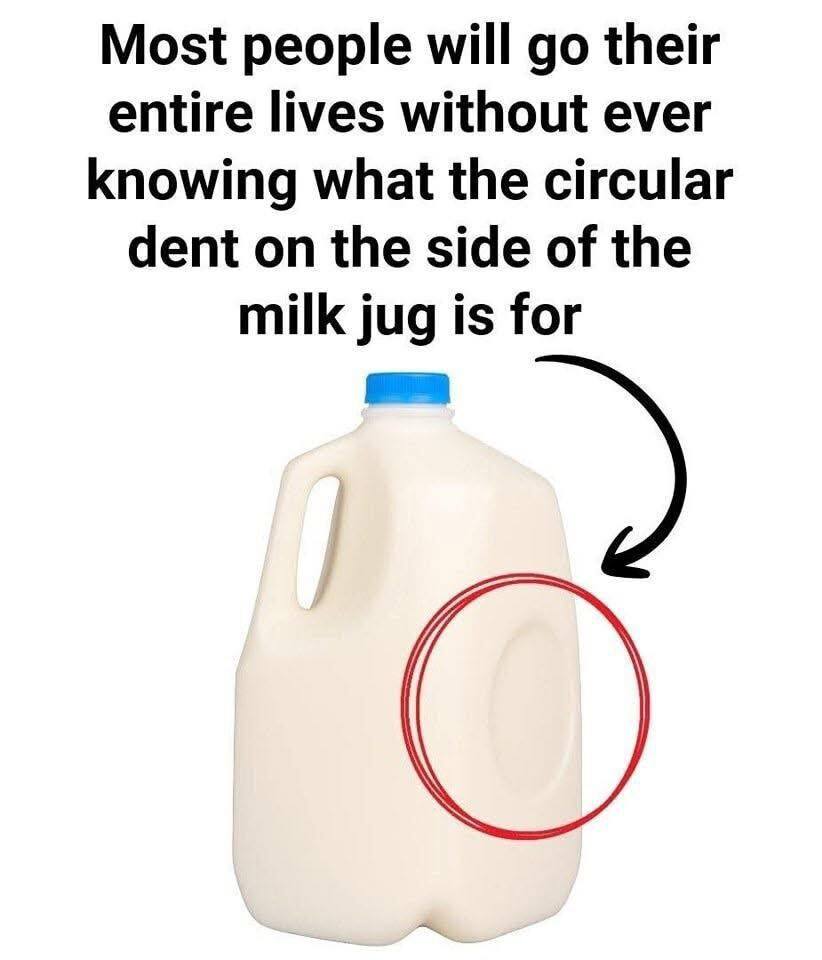The Hidden Genius of the Milk Jug Dent
Ever noticed the small, circular dent on the side of a plastic milk jug? It’s something most of us have seen but never really thought about. At first glance, it may seem like a random flaw or a meaningless design choice. However, that little circle is a clever piece of engineering that serves multiple purposes — keeping your milk safe, your jug intact, and your fridge cleaner.
Next time you reach for your morning milk, take a closer look. That dent has more to do with your breakfast than you might think.
Why Does the Milk Jug Have a Dent?
It’s not there by accident. That round indentation is part of the jug’s design, serving three primary functions: pressure control, durability, and efficiency.
It Manages Pressure Changes
Milk, like any liquid, expands and contracts with temperature shifts. When the milk moves from a warm delivery truck to a cold fridge, the temperature change causes the liquid to either expand or shrink. Without a way to accommodate this change in pressure, the jug could warp, crack, or even burst — especially if the milk freezes.
The dent acts as a built-in “pressure cushion,” flexing in or out as needed to absorb the changes in pressure. This simple feature prevents damage to the jug, which could otherwise result in leaks or spills.
It Helps Prevent Spills and Breakage
If you’ve ever dropped a gallon of milk, you know the chaos that follows — sticky floors and wasted money. The dent also functions as a kind of shock absorber. When the jug is dropped or handled roughly, the dent allows the container to flex slightly, distributing the impact rather than cracking or splitting open.
This flexibility reduces waste and damage, which is great for producers and consumers alike. It means fewer accidents and less mess.
It Adds Strength Without Extra Plastic
Plastic jugs are designed to be lightweight yet durable. Adding more material for strength would make them heavier and more expensive. Instead, the circular dent increases the jug’s structural integrity by reinforcing it through its shape, not material.
Much like the arches in a bridge or the curves in a car frame, the dent strengthens the jug by distributing stress evenly. This is a smart, efficient design that makes the jug stronger without adding unnecessary weight or cost.
A Hidden Indicator for Spoiled Milk
Here’s an interesting twist: that dent can also give you a clue about your milk’s freshness.
When milk spoils, bacteria release gas, causing pressure to build up inside the jug. This can cause the dent to push outward or even bulge. If you notice that the normally indented circle is now protruding, it’s a sign that something may be off — even before you check the expiration date.
Of course, not every bulge means the milk is bad; some pressure changes are harmless. But if the dent is sticking out and the milk smells sour or the jug feels unusually tight, it’s a red flag that the milk might have spoiled.
Why a Circle?
You might wonder why engineers chose a circle, rather than another shape, for this pressure zone. The answer lies in physics. Circles distribute pressure evenly across their surface, making them less prone to cracking than edges or corners. A circle also has the added benefit of being easy to mold during mass production, keeping manufacturing costs low and quality consistent.
It’s not just a design choice — it’s functional perfection.
Other Subtle Design Features
The milk jug may seem like an everyday object, but it’s full of thoughtful details. For example:
The handle hole isn’t just for grip; it reduces plastic use without sacrificing strength, making the jug lighter and more eco-friendly.
The ridges at the bottom of the jug stabilize it, keeping it steady on uneven surfaces and preventing spills during production.
The color of the cap often signifies the milk type — red for whole, blue for 2%, green for 1%, and so on — making it easy for shoppers to identify what they’re looking for.
These small features add up to make the milk jug a remarkably practical and well-designed product.
Small Design, Big Impact
The plastic milk jug might not be a flashy invention, but it’s a quiet triumph of practical engineering. The dent alone has probably saved countless gallons of milk from bursting, prevented accidents during transport, and reduced plastic waste by eliminating the need for thicker material.
It’s a reminder that even the most mundane objects around us often have deep roots in innovation and problem-solving, all aimed at making life a little easier.
Next time you open your fridge, take a moment to appreciate that little circular dent. It’s not just there for decoration. It’s a pressure regulator, a shock absorber, and a structural reinforcement all rolled into one.
And if you ever spot the dent bulging outward, don’t just ignore it — that’s your milk’s way of saying, “Something’s not right.”
So, when someone asks you about that dent, you’ll know: it’s not a flaw. It’s a thoughtful piece of design, combining physics, engineering, and practicality into one small but powerful feature.
